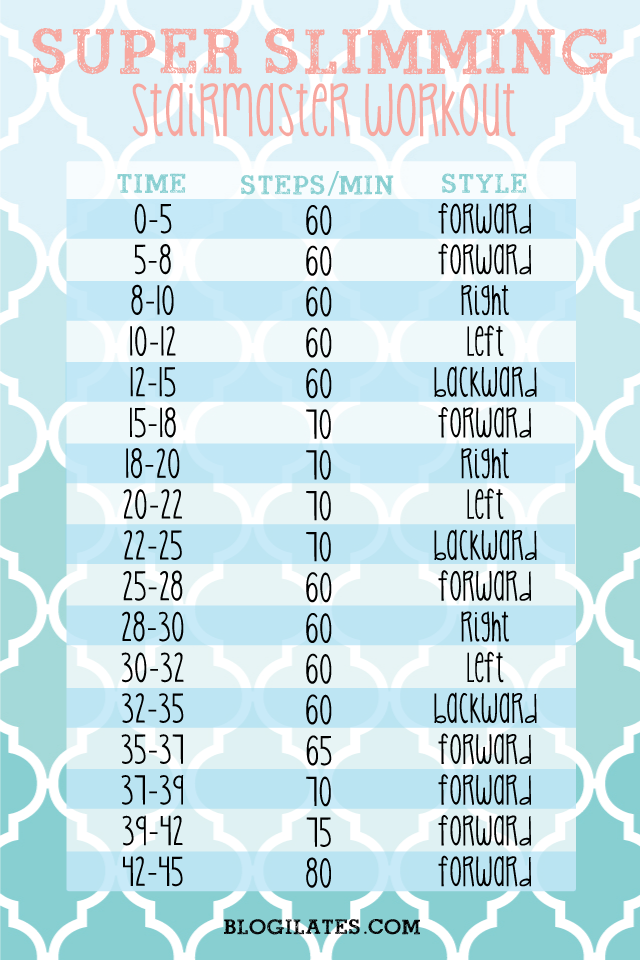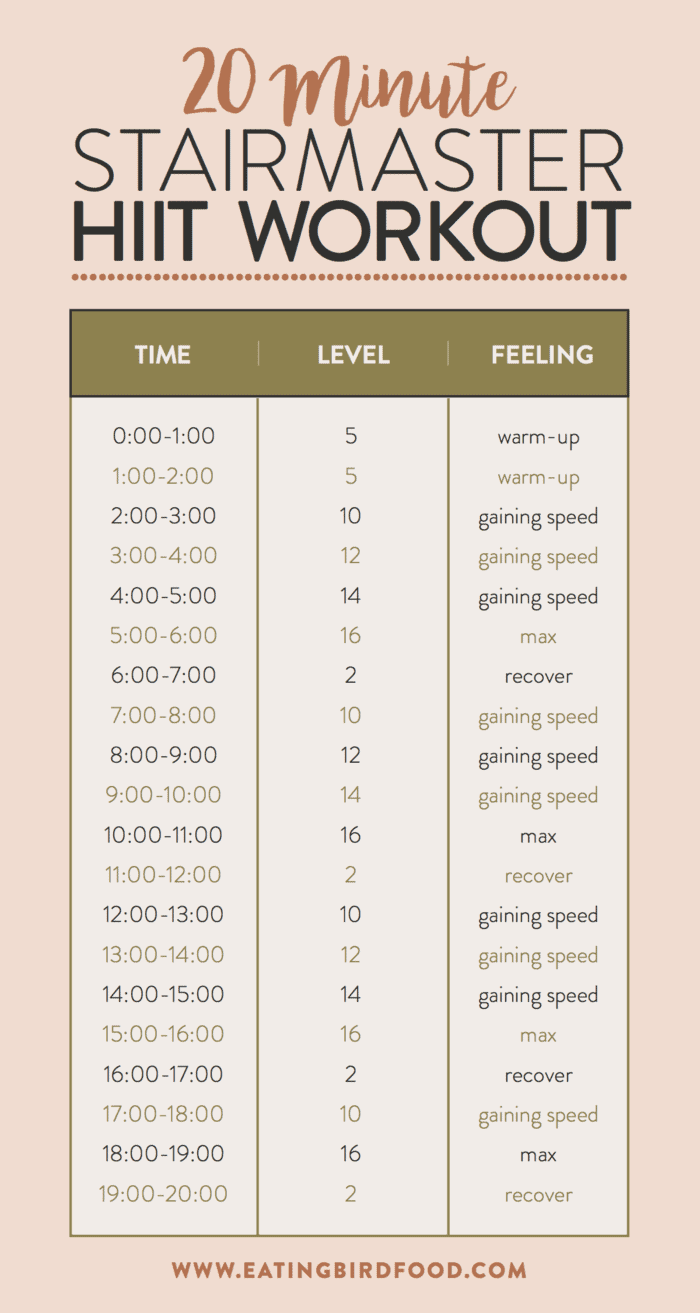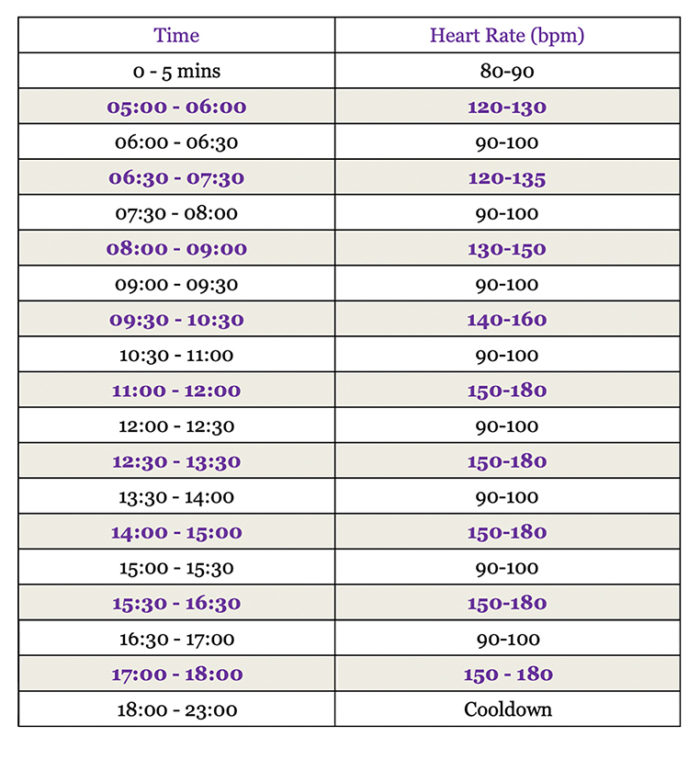Are you looking for an efficient workout that will help you maximize fat loss in just 30 minutes? If so, then the 30-Minute Stairmaster Workout might be the perfect solution for you!
In this workout, you’ll be using the Stairmaster machine to boost your heart rate, torch calories, and target various muscle groups all at once. Not only does this workout allow you to burn a significant amount of calories in a short amount of time, but it also provides a great cardiovascular challenge.
By incorporating interval training and resistance, the Stairmaster workout helps you build endurance and strength while promoting fat loss.
In the article, you will learn the step-by-step guide to the 30-Minute Stairmaster Workout, including how to properly warm up, the specific workout routine, and how to cool down effectively. You will also find tips on how to adjust the intensity to your fitness level and avoid common mistakes.
So if you’re ready to take your fat loss journey to the next level, keep reading and discover how this 30-Minute Stairmaster Workout can help you achieve your goals!

Benefits of Stairmaster Workouts
Increasing calorie burn
Are you looking for a workout that can help you maximize fat loss? Look no further than the Stairmaster! This incredible machine offers a host of benefits that can help you shed those extra pounds and achieve your fitness goals. One of the biggest advantages of incorporating Stairmaster workouts into your routine is the significant increase in calorie burn.
When you use the Stairmaster, you engage large muscle groups in your lower body, such as your glutes, quads, and calves. This increased muscle activation leads to a higher caloric expenditure during your workout.
In fact, according to the American College of Sports Medicine, a 30-minute session on the Stairmaster can burn approximately 300-500 calories, depending on your weight and intensity level. So, if you’re trying to lose weight, incorporating Stairmaster workouts into your routine can be a game-changer!
Building cardiovascular endurance
In addition to boosting calorie burn, using the Stairmaster can also improve your cardiovascular endurance. As you climb the stairs, your heart rate increases, and your lungs have to work harder to supply oxygen to your muscles. Over time, this constant cardiovascular challenge strengthens your heart and improves your lung capacity, leading to better overall endurance.
By consistently challenging your cardiovascular system with Stairmaster workouts, you can increase your stamina and improve your ability to perform other physical activities. Whether you’re a recreational athlete or just looking to improve your everyday fitness, building cardiovascular endurance with the Stairmaster can help you reach new heights.
Toning lower body muscles
Another significant benefit of Stairmaster workouts is the toning and strengthening of your lower body muscles. Climbing stairs is a compound movement that targets multiple muscle groups simultaneously. This not only helps you build lean muscle mass but also improves your overall muscular endurance.
The primary muscles targeted during a Stairmaster workout include your glutes, quadriceps, hamstrings, and calves. As you push through the steps, these muscles contract and lengthen, stimulating muscle growth, improving definition, and giving your legs a toned appearance. So, if you’re looking to sculpt your lower body and achieve those enviable legs, incorporating Stairmaster workouts into your routine is a must!
Understanding the Stairmaster Machine
Machine features and settings
Before embarking on your Stairmaster journey, it’s essential to familiarize yourself with the machine’s features and settings. The Stairmaster typically consists of a revolving staircase with two pedals that move independently. It also comes equipped with various resistance levels, allowing you to customize the intensity of your workout.
Most Stairmaster machines also have additional features such as heart rate monitors, built-in workout programs, and step counters. Familiarize yourself with these features, as they can provide valuable information and help you track your progress over time.
Proper body positioning
To get the most out of your Stairmaster workout, it’s crucial to maintain proper body positioning throughout your session. Start by standing tall with your feet firmly planted on the pedals. Avoid leaning forward or backward, as this can put unnecessary strain on your lower back and create an imbalance in muscle engagement.
Engage your core muscles by pulling your belly button in towards your spine. This not only helps maintain stability but also supports your lower back during the climbing motion. Ensure your shoulders are relaxed and your chest is lifted, allowing for proper breathing and full range of motion.
Choosing the right intensity level
Selecting the appropriate intensity level on the Stairmaster is essential to optimize your workout. If you’re new to using the machine or are looking for a more moderate intensity session, start with a lower resistance level. This allows your body to adapt gradually and reduces the risk of muscle soreness or injury.
As you become more comfortable with the Stairmaster, progressively increase the resistance level to challenge your muscles and push yourself to new heights. Remember, the key to enhancing fat loss and building endurance is to constantly challenge your body. So, don’t be afraid to increase the intensity as you get stronger and fitter.

Warm-Up and Stretching
Importance of warming up
Before diving into your 30-minute Stairmaster workout, it’s crucial to warm up your muscles properly. Warming up prepares your body for the physical demands of exercise, increases the range of motion in your joints, and enhances your overall performance.
A proper warm-up typically consists of performing dynamic movements that replicate the motions you’ll be doing during your workout. This could include exercises such as walking lunges, leg swings, and hip circles. Aim to spend at least 5-10 minutes engaging in dynamic movements to raise your body temperature and get your blood flowing.
Dynamic stretching exercises
Following your warm-up, it’s essential to incorporate dynamic stretching exercises to further prepare your muscles for the Stairmaster workout. Unlike static stretching, which involves holding a stretch for an extended period, dynamic stretching involves actively moving through a controlled range of motion.
Dynamic stretching exercises for the Stairmaster can include leg swings, walking knee hugs, and high knees marching in place. These movements help improve flexibility, increase circulation to the muscles, and enhance your overall performance during the workout.
Structured Workout Plan
Interval training technique
To maximize fat loss and improve your fitness level, it’s highly recommended to incorporate interval training into your Stairmaster workout. Interval training involves alternating between periods of high-intensity exercise and low-intensity recovery or rest periods. This method has been proven to be highly effective for fat burning and increasing cardiovascular fitness.
During your 30-minute Stairmaster workout, aim to alternate between short bursts of high-intensity climbing and brief periods of active recovery. For example, you could sprint up the steps at maximum effort for 30 seconds, followed by a slow and controlled climb at a lower intensity for 60 seconds. Repeat this pattern throughout your workout to keep your heart rate elevated and maximize calorie burn.
Setting workout duration and intensity
When designing your Stairmaster workout plan, it’s crucial to determine the appropriate duration and intensity level that suits your fitness level and goals. If you’re new to using the Stairmaster or are just starting your fitness journey, begin with a shorter session, such as 15-20 minutes, and gradually increase the duration over time.
In terms of intensity, aim to work at a level that challenges your muscles and elevates your heart rate without compromising your form or risking injury. As mentioned earlier, increasing the resistance level on the Stairmaster is an excellent way to add intensity. However, you can also increase the speed of your climbing, incorporate intervals of skipping steps, or climb backwards to amp up the challenge.
Alternating between different resistance levels
To keep your Stairmaster workout challenging and prevent plateau, it’s beneficial to alternate between different resistance levels throughout your session. Changing the resistance level not only challenges your muscles in different ways but also helps to vary the intensity and keep your body guessing.
Start your workout with a moderate resistance level to warm up your muscles. As you progress, increase the resistance gradually to challenge yourself and continue building strength and endurance. Towards the end of your workout, consider decreasing the resistance level slightly to allow for a cool-down period.
Incorporating high-intensity intervals
High-intensity intervals are a powerful tool to incorporate into your Stairmaster workout. These short bursts of maximum effort require you to work at your maximum capacity, pushing your cardiovascular system to its limits. This type of exercise not only increases calorie burn but also helps to improve your overall fitness level.
To incorporate high-intensity intervals, choose a portion of your workout where you feel comfortable pushing yourself to the max. It could be a specific resistance level or a particular duration, such as sprinting for 30 seconds or climbing at a high resistance for one minute. Listen to your body and gradually increase the intensity and duration of these intervals as you become more conditioned.
Tracking progress and increasing difficulty
To ensure progress and continued improvement, it’s essential to track your performance during your Stairmaster workouts. This can be done by keeping a log of your workout duration, intensity level, and any additional challenges or intervals you incorporate.
Tracking your progress not only helps you see how far you’ve come but also allows you to set specific goals and targets for future sessions. For example, you could aim to increase your workout duration by one minute each week or aim to climb the steps at a higher resistance level.

Specific Stairmaster Exercises
Single step climbing
One of the most straightforward yet effective exercises on the Stairmaster is single step climbing. This exercise involves climbing the stairs one step at a time, focusing on maintaining a consistent rhythm and engaging your glutes, quads, and calves.
To perform single step climbing, start by stepping onto the machine and gripping the handles lightly for balance. Plant your feet firmly on the pedals and begin climbing, focusing on using your legs to drive each step. Keep your torso upright and your core engaged throughout the exercise. Aim to maintain a steady pace and avoid relying too heavily on your arms for support.
Double step climbing
Double step climbing is another excellent exercise to add variety and challenge to your Stairmaster workout. This exercise involves climbing the stairs by taking two steps at a time, engaging more muscles and increasing the intensity of the workout.
To perform double step climbing, position yourself on the Stairmaster, similar to single step climbing. Instead of taking one step at a time, lift your legs and take two steps together as you climb. Focus on using the power of your legs to drive each step and maintain an upright posture. This exercise targets your glutes, hamstrings, and quadriceps, giving your lower body an extra burn.
Skipping steps
To further intensify your Stairmaster workout, consider incorporating intervals of skipping steps. This exercise involves intentionally skipping steps while climbing, which engages more muscle fibers and increases the difficulty level of the workout.
To perform skipping steps, start by climbing the stairs as you would in single step climbing. After a few minutes, begin to lift your lead foot higher and purposely skip a step, landing on the next one with your other foot. Alternate between skipping steps and taking regular steps throughout your workout to challenge your muscles in new ways.
Side steps
Side steps on the Stairmaster are an excellent way to target your gluteus medius muscles, which are located on the side of your hips. This exercise helps strengthen these muscles, improving overall stability and preventing imbalances.
To perform side steps, stand on the Stairmaster in a regular position, facing forward. Instead of climbing straight up, shift your weight to one leg and step sideways onto the next step with your other foot. Repeat this movement, alternating sides with each step. Focus on maintaining proper form and engaging your core for stability.
Backwards climbing
Backwards climbing on the Stairmaster provides an entirely different challenge and engages different muscle groups. This exercise targets your glutes, hamstrings, and calves in a unique way, helping to improve muscular balance and coordination.
To perform backwards climbing, position yourself on the Stairmaster facing the opposite direction. Begin climbing the stairs by stepping one foot at a time, focusing on maintaining a controlled and balanced movement. Keep your core engaged, and avoid leaning too far forward or backward. As you become more comfortable, increase the resistance to make it more challenging.
Maintaining Proper Form
Engaging core muscles
Regardless of the specific Stairmaster exercise you’re performing, it’s crucial to engage your core muscles throughout the entire workout. The core plays a vital role in maintaining stability, posture, and balance, preventing potential injuries and allowing for optimal muscle engagement.
To engage your core, focus on pulling your belly button in towards your spine and maintaining this contraction throughout your workout. Avoid holding your breath and remember to breathe evenly and deeply. Engaging your core not only helps protect your lower back but also enhances your overall performance and ensures proper alignment.
Keeping a straight posture
Maintaining a straight posture on the Stairmaster is key to optimizing your workout and preventing unnecessary strain on your body. Aim to keep your torso upright, shoulders relaxed, and chest lifted throughout the entire session.
Avoid leaning too far forward or backward, as this can put undue stress on your lower back and lead to inefficient muscle activation. Keep your gaze forward and focus on your climbing technique. By maintaining a straight posture, you’ll engage the correct muscle groups and ensure an efficient and effective workout.
Avoiding excessive leaning
While it’s important to maintain an upright posture, it’s also essential to avoid excessive leaning during your Stairmaster workout. Excessive leaning can occur when you rely too heavily on the handrails or use your upper body to push yourself up the steps.
To avoid excessive leaning, aim to use your lower body and core muscles to power through the steps. Lightly grip the handrails for balance but avoid putting too much weight on them. By relying on your lower body for support, you’ll engage your muscles more effectively and achieve better results.
:max_bytes(150000):strip_icc()/GettyImages-1172449530-2000-d2f921087b3e493b987371d37a1cfc4b.jpg)
Cool-Down and Recovery
Importance of cooling down
Just as warming up is essential before your Stairmaster workout, cooling down afterward is equally important. Cooling down helps your body transition from the high-intensity workout to a state of rest, gradually lowering your heart rate and reducing the risk of muscle soreness or dizziness.
To cool down effectively, spend at least 5-10 minutes at a lower intensity on the Stairmaster. Gradually decrease the resistance level and pace to allow your body to recover. This gentle activity helps facilitate the removal of waste products, such as lactic acid, from your muscles and aids in the recovery process.
Static stretching exercises
Once you’ve completed your cool-down on the Stairmaster, it’s beneficial to incorporate static stretching exercises to further aid in your recovery. Static stretching involves holding a stretch for an extended period to improve flexibility and promote muscle relaxation.
Perform static stretches targeting your lower body, such as quadriceps stretches, hamstring stretches, and calf stretches. Hold each stretch for 15-30 seconds, ensuring that you feel a gentle pull but not pain or discomfort. By stretching your muscles after your Stairmaster workout, you can improve flexibility, reduce muscle tension, and enhance your overall recovery.
Recovery techniques
After your Stairmaster workout, it’s essential to prioritize recovery to allow your body to rebuild and repair itself. Proper recovery techniques can help alleviate muscle soreness, prevent injury, and improve overall performance in subsequent workouts.
Some effective recovery techniques include foam rolling, getting plenty of rest and sleep, hydrating adequately, and nourishing your body with healthy and balanced meals. Additionally, incorporating relaxation techniques such as yoga, meditation, or deep breathing exercises can help reduce stress and promote overall well-being.
Additional Tips for Success
Staying hydrated
Hydration is key to maximizing the benefits of your Stairmaster workout and maintaining optimal performance. Aim to drink water before, during, and after your session to replenish fluids lost through sweat.
Keep a water bottle nearby and take regular sips throughout your workout to stay hydrated. Remember, dehydration can lead to decreased performance and hinder your ability to burn fat effectively. So, make it a habit to drink plenty of water before, during, and after your Stairmaster workouts.
Wearing proper workout attire
Having the right workout attire can significantly impact your comfort and performance during your Stairmaster workouts. Opt for comfortable, moisture-wicking fabrics that allow your skin to breathe and keep you cool.
Choose supportive athletic shoes that provide stability and cushioning for your feet while climbing. Investing in proper workout attire not only enhances your comfort but also helps prevent blisters, chafing, and potential injuries.
Listening to your body
One of the most critical aspects of any fitness routine is listening to your body and paying attention to how you feel during and after exercise. While it’s important to challenge yourself and push your limits, it’s equally important to recognize when you need to rest or modify your workout.
If you experience any pain or discomfort during your Stairmaster workout, it’s essential to stop and assess the situation. Pushing through pain can lead to injury and hinder your progress. Always prioritize your safety and well-being by listening to your body and adjusting your workout intensity or duration accordingly.
Combining with other exercises
While the Stairmaster is an excellent standalone workout, combining it with other exercises can further enhance your fat loss and overall fitness level. Consider adding strength training exercises, such as lunges, squats, or step-ups, to your routine to build lean muscle mass and increase your metabolic rate.
You can also incorporate other cardiovascular exercises, such as cycling, swimming, or running, to diversify your workouts and prevent boredom. A combination of different exercises targets various muscle groups and helps keep your body challenged and your mind engaged.
Seeking professional guidance if needed
If you’re new to using the Stairmaster or have any pre-existing medical conditions or injuries, it’s advisable to seek professional guidance before starting a new exercise program. A certified personal trainer or fitness professional can assess your fitness level, help you create a personalized workout plan, and ensure that you’re using proper form and technique.
Professional guidance is especially crucial if you’re recovering from an injury or have any specific limitations. A qualified trainer can provide modifications or alternative exercises to accommodate your needs and prevent further injury.

Common Mistakes to Avoid
Overtraining
While the Stairmaster can be an effective tool for fat loss, it’s important to avoid overtraining. Overtraining occurs when you don’t allow your body enough time to recover and repair itself between workouts.
Failing to incorporate rest days or engaging in high-intensity workouts every day can lead to decreased performance, muscle fatigue, and an increased risk of injury. Ensure you schedule rest days or alternative activities into your weekly routine to give your body the rest it needs.
Relying solely on Stairmaster workouts
While the Stairmaster is a fantastic exercise machine, relying solely on it for your workouts can lead to a plateau in your progress. It’s essential to incorporate a variety of exercises and activities into your routine to engage different muscle groups and prevent boredom.
Combining your Stairmaster workouts with strength training, flexibility training, and cardiovascular exercises can help you achieve a well-rounded fitness level and maximize your fat loss. Explore different forms of exercise and find activities that you enjoy to keep yourself motivated and engaged.
Using incorrect form
Using incorrect form on the Stairmaster not only diminishes the effectiveness of your workout but also increases the risk of injury. Always prioritize proper form and technique over speed or intensity.
If you’re unsure about your form, consider working with a certified personal trainer who can assess your technique and provide guidance and corrections. Starting with the correct form from the beginning sets the foundation for a safe and effective workout routine.
Conclusion
Maximizing fat loss and achieving your fitness goals can be challenging, but with a well-designed Stairmaster workout plan, you’re well on your way to success. Incorporating Stairmaster workouts into your routine offers numerous benefits, including increased calorie burn, improved cardiovascular endurance, and toned lower body muscles.
By understanding the Stairmaster machine, warming up properly, and structuring your workouts with interval training in mind, you can optimize your results. Specific Stairmaster exercises, such as single step climbing, double step climbing, skipping steps, side steps, and backwards climbing, target different muscle groups and add variety to your workouts.
Maintaining proper form and engaging your core muscles ensure efficient muscle activation and prevent injuries. Don’t forget to cool down and incorporate static stretching exercises to promote proper recovery. Additional tips for success include staying hydrated, wearing proper workout attire, listening to your body, incorporating other exercises, and seeking professional guidance if needed.
In conclusion, a 30-minute Stairmaster workout can be a game-changer in your fitness journey. Make the most of your workouts, maintain consistency, and push your limits to achieve your fat loss and fitness goals. So, step onto the Stairmaster, enjoy the burn, and watch as your body transforms.




